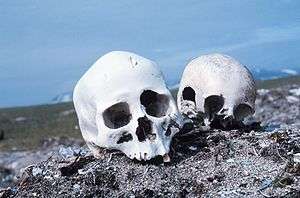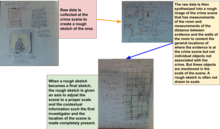Forensic arts
Forensic art is any art used in law enforcement or legal proceedings. Forensic art is used to assist law enforcement with the visual aspects of a case, often using witness descriptions and video footage.[1]
| Part of a series on |
| Forensic science |
|---|
 |
|
It is a highly specialised field that covers a wide range of artistic skills, such as composite drawing, crime scene sketching, image modification and identification, courtroom drawings, demonstrative evidence, and postmortem and facial approximation aids. It is rare for a forensic artist to specialise in more than one of these skills.[2] The following is a breakdown of different skills and what they involve:
- Composite Drawing: the main objective is to help investigators generate leads based on physical descriptions. This is usually drawn by hand; an artist who is trained in interviewing victims and witnesses uses the information provided to draw what is described.[3] Composite art produces a single, graphic image that is designed to be a likeness or similarity of the individual.[4]
- Image Modification: this is used to change and enhance a photograph in order to help an investigator and/or trial attorney. Examples of this include age progression/regression (see below),[5] and the clarifying of images, such as from CCTV footage, to identify an individual.[4]
- Image Identification: this is the recording a person's distinguishing features for future reference. Investigators can use this tool to identify suspects who attempt to change their appearance to evade capture, as well as in the study of cold cases in which individuals may have changed their appearance since the event.[5]
- Crime Scene Sketching: the drawing of a crime scene; in the sketch, an investigator includes measurements and dimensions to aid in displaying the layout of the scene. This helps support the information shown in photographs of the scene.[6]
- Demonstrative Evidence: any visible, physical evidence used in legal proceedings. These are used to demonstrate aspects of the case, reconstruct an event, and illustrate what happened. There are two categories of demonstrative evidence; court displays and investigative aids.[5]
- Postmortem Drawing: when an artist either looks at a deceased person's photograph or their remains to help identify who the person is and what they looked like prior to their death. This helps most in cases where the body is too damaged by an accident or decomposition.[5][4]
- Age Progression/Regression: useful to determine what a person's appearance before or after a period of time. This is most commonly used in missing persons cases or during cold cases when investigators need an idea of what an individual looked like years prior to or following the investigation.
- Forensic Sculpture: this is used to create three-dimensional models, usually using the skull of the victims. Other features are added such as fake eyes and wigs to add realism. This process can also inform the investigators of certain characteristics of the victim - such as age, race, and gender - through a detailed knowledge of the intricacies of skeletal structure and other corresponding features such as dental records. It is later photograph and used like postmortem and composite drawings. However, because forensic sculpture relies heavily on assumptions made by the artist, it is not considered a legally recognised technique for positive identification, and is thus used in an advisory capacity only.[7]
- Collaboration: forensic artists, anthropologists and other professions are used to help determine the age, sex, and race of an identified skull.[8]
Many forensic artists do the job as a collateral duty to their "regular" job in law enforcement, such as police officer, crime scene tech, etc. Such forensic artists perform their work while on a fixed salary and are not additionally compensated for artistic duties. There are few full-time forensic artist jobs available. Most full-time artists work in large cities, or in state or federal agencies. "Freelancing" in forensic art is a difficult career path, as ties to law enforcement are a necessary part of the job, and agencies have limited budgets to pay outside contractors.
The skill of facial approximation is closely associated and related to forensic anthropology in that an artist specializes in the reconstruction of the remains of a human body. Generally this discipline focuses on the human face for identification purposes. The forensic artist can create a facial approximation in a number of ways to include 2D (drawings), 3D (sculptures) and other methods using new computer technology. Forensic artists generally can add greater character and make their subjects come back to "life".
Methods of Manual 3d construction
- Anthropometric was a method developed by Wilton M. Krogman in 1946 .[9]
- Facial muscles are recorded by a highly trained professional. This job is particularly tedious, which is why most do not use this method.
- Computerized 3d forensic facial reconstruction- manual model clay techniques are used within this method. Computer systems vary, in that some computerized systems used 3D animation software to model the face onto the skull, while other systems use a virtual sculpture system with Haptic feedback[9]
- Haptic Feedback- The ability to feel the surface of the skull during analysis and also provide important skeletal details for facial reconstruction such as muscle attachment strength, position of eye, position of malar tubercle etc.[9]
Face model creation
When creating a face model, the forensic artist looks at whether the person is masculine or feminine, as well as their skin tone, age, wrinkles, freckles, the shadow of the beard, and attractiveness. There are three segments that they examine:
- Face shape: round, narrow, heart shape, high/low cheeks, high/low chin, double chin, the distance between lips and nose.
- Eyes: round, upwards/downwards, the distance of eyeballs, eye color, thin/thick eyebrows, high/low arch brow, distance between both eyebrows, distance between eyebrows and eyes.
- Hair: the 3D models have not been programmed to be used with hair, therefore, hair cannot be used the same way as facial attributes. A profile and frontal image of a person is used where 5 to 15 different key features of each hairstyle are selected. These different hairstyles features are from a database used by these professionals. The styles are put into the system where the algorithm automatically estimates the structure of the face. The system is also able to depict different shade of color.[10]
Becoming a Forensic Artist
To qualify for a professional certification for forensic arts - such as the Forensic Art Certification, which is provided through the International Association for Identification - applicants can focus on one or more of the three available categories of professional designation: composite imaging, facial reconstruction, and image enhancement/age progression,[4] and must:
- have at least 80 hours of IAI-approved forensic art training[11]
- have at least 40 hours of related workshops, lectures, and short program training
- have at least 2 years of experience as forensic arts
- provide at least 30 forensic art examples that include age progressions, composites, and reconstructions
- have a portfolio that demonstrates their forensic art techniques (must include at least 10 forensic art images that were prepared for law enforcement investigation cases)[12]
References
- "What is Forensic Art? - Forensic Faces Institute". forensicfaces.weebly.com. Retrieved 2017-11-06.
- "History of the I.A.I. Forensic Art Discipline". www.theiai.org. Archived from the original on 2017-10-06. Retrieved 2007-12-31.
- "Forensic Art Defined and Explained". Forensic Magazine. 2004-12-01. Retrieved 2017-11-06.
- "Forensic Artist Job Description, Education Requirements and Salary Expectations". www.crimesceneinvestigatoredu.org. Retrieved 2018-01-29.
- https://search.proquest.com/docview/1698608879
- MAYO, KRISTI. "Evidence Technology Magazine – Documenting the Crime Scene". www.evidencemagazine.com. Retrieved 2017-11-06.
- Helmer et al. Assessment of the Reliability of Facial Reconstruction.
- Taister, Karen T. Taylor, Taylor, Michael A. Taister. "Book Review of Forensic Art and Illustration (by Taylor), by Taister (Forensic Science Communications, January 2001)". FBI. Retrieved 2017-12-04.
- "What is Anthropometric Measurement? - Tools, Purpose & Methods – Video & Lesson Transcript". study.com. Retrieved 2017-12-05.
- "EBSCOhost Login". search.ebscohost.com.
- "Forensic Artist Job Description, Education Requirements and Salary Expectations". www.crimesceneinvestigatoredu.org. Retrieved 2017-12-05.
- "Forensic Artist Job Description, Education Requirements, and Salary Expectations". www.crimesceneinvestigatoredu.org. Retrieved 2017-12-04.
External links
